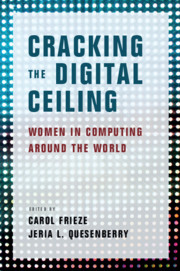Book contents
- Cracking the Digital Ceiling
- Cracking the Digital Ceiling
- Copyright page
- Contents
- Contributors
- Acknowledgments
- Introduction
- Part I Global Perspectives
- Part II Regional Perspectives
- Part III Cultural Perspectives from the United States and Europe
- Part IV Cultural Perspectives from Asia-Pacific
- 14 More Chinese Women Are Needed to Hold Up Half the Computing Sky
- 15 How the Perception of Young Malaysians toward Science and Mathematics Influences Their Decision to Study Computer Science
- 16 Women as Software Engineers in Indian Tamil Cinema
- 17 Women in Computing Education
- 18 Challenging Attitudes and Disrupting Stereotypes of Gender and Computing in Australia
- Conclusion
- Notes
- Index
- References
14 - More Chinese Women Are Needed to Hold Up Half the Computing Sky
from Part IV - Cultural Perspectives from Asia-Pacific
Published online by Cambridge University Press: 10 October 2019
- Cracking the Digital Ceiling
- Cracking the Digital Ceiling
- Copyright page
- Contents
- Contributors
- Acknowledgments
- Introduction
- Part I Global Perspectives
- Part II Regional Perspectives
- Part III Cultural Perspectives from the United States and Europe
- Part IV Cultural Perspectives from Asia-Pacific
- 14 More Chinese Women Are Needed to Hold Up Half the Computing Sky
- 15 How the Perception of Young Malaysians toward Science and Mathematics Influences Their Decision to Study Computer Science
- 16 Women as Software Engineers in Indian Tamil Cinema
- 17 Women in Computing Education
- 18 Challenging Attitudes and Disrupting Stereotypes of Gender and Computing in Australia
- Conclusion
- Notes
- Index
- References
Summary
Since Deng Xiaoping’s economic reforms starting in 1978, the Chinese government has continuously improved the basic laws and regulations that guarantee women’s economic rights and employment rights. Chinese women can participate equally in economic development, and enjoy the fruits of reform and development on an equal footing with men. In China (Aaltio and Huang, 2007), working women now account for 47.0% of the total labor force, higher than the world average of 40.8%. However, in the computing industry, the proportion of female practitioners in China is about 7% (Proginn and Juejin, 2017; Proginn, 2018), significantly lower than 17% in United States (Elizabeth, 2017). The problem of the small proportion of Chinese computing female practitioners should be remedied.
- Type
- Chapter
- Information
- Cracking the Digital CeilingWomen in Computing around the World, pp. 263 - 275Publisher: Cambridge University PressPrint publication year: 2019



